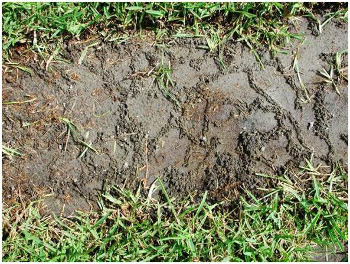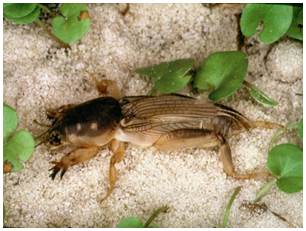- Return to Article Of The Month index
Pesky Pest or Serious Threat?
December, 2014
Ashley Fluke, Livestock/Forage Extension Agent - Osceola County
Across the state of Florida, cattlemen have been seeing some common issues in grazed pastures. There have been numerous reports of yellowing in bahiagrass and bermudagrass pastures, root decline in bahiagrass pastures, fertility concerns in soils, and increasing pest problems in many areas. When asking a cattle producer about raising his crop, he will often tell you that growing grass is a main priority because without grass you can’t raise cows too well in Florida. Forages are critical to the success of a beef operation and so when there are situations adversely impacting forage performance it becomes a very crucial issue and can have a substantial economic impact. Being in the agricultural industry generally requires a sound understanding of business planning and financial management. There are a lot of known practices that enhance forage production and cattle performance but it is the value in implementing those practices that matters in the end. What is the return on my investment? So, with some of the current challenges producers face, there are questions regarding economics and the environment that arise in order to find the best solutions.
Let’s discuss a current pest issue that seems to be on the rise in several parts of the state. In the late 1990’s and early 2000’s ranchers throughout Florida indicated having significant amounts of pasture damaged by mole crickets. There are three species of mole cricket that have been identified as damaging to crops in the southeastern United States. They are the Tawny, Southern, and Short-winged, with the first two being noted as most detrimental to pasture. The exact cause of mole cricket infestation is not entirely understood but their preferable conditions are apparent. Mole crickets favor moist soil, warm temperatures, and typically can be found in pastures with an acidic (low) pH which makes Florida pastures quite inviting. While there is a link between low soil pH, stressed pasture, and mole cricket population there are still undetermined factors. The pest also seems to be more active in certain areas of the state than others. An example is Osceola County, especially the lower 2/3 of it. At certain times of the year you can drive down Canoe Creek Road and mole crickets will flock your windshield with a vengeance, especially at night as they are attracted to lights. Thousands of acres have been affected in the county. Then there are other counties that express little concern regarding mole crickets. For several years there was not as much damage to pastures as in the past but the last two years ranchers throughout the state are noticing signs of mole cricket activity and feeling the impact of the resulting grazing loss. It brings us back to realizing the value in addressing the situation. How much damage is there and is it cost effective to treat it?
There are a few methods utilized for controlling mole crickets. There are biological and chemical control options. In 2001 and 2002 the University of Florida applied the mole cricket nematode, Steinernema scapterisci, in 32 counties. According to the UF/IFAS Entomology and Nematology Department, the study of this biological control method resulted in a recorded 85% decline in mole crickets and 40-95% recovery of bahiagrass pasture within three years of nematode application. Ranchers were able to purchase the nematode and many applied it to pastures. Some found great results and others did not have as much success. Some critical factors affecting nematode success include moisture levels, temperature, and application timing as they primarily attack adult mole crickets. Tawny and Southern mole crickets reach the adult stage in August-September and nymphs that are dormant through winter become adults in April. There are a few liquid and bait options that can be highly affective but again, timing is critical and if there is too much moisture or rainfall the bait can be rendered ineffective. Turf and sod producers have several more chemical options labeled for mole cricket control. They too experience damage from mole crickets and can experience significant loss from the pest. As there seems to be an increase in mole cricket activity, it is wise to monitor pastures and test soil pH and fertility. An initial step in controlling pests is prevention by monitoring pastures and maintaining healthy conditions for growth. The obvious sign of mole cricket presence is the tunneling on soil surface which can weaken the root system. There is a technique using dish soap to flush mole crickets and determine the population size in a particular pasture and you can contact your Extension Agent for more information.
Currently, pastures are being assessed and mole crickets are being collected to see if any nematode activity still exists. There are no mole cricket specific nematode’s readily available at this time commercially in the United States. However, with further surveying of pasture conditions and mole cricket populations there may be opportunity for trial work and nematode product from an international company. Questions regarding amount of damage, economic impact to the industry, market possibility, and overall severity and significance of the issue will be addressed. Agricultural producers face many challenges and even with beef prices at the current level, input costs are high and every business decision must be taken with great consideration.



